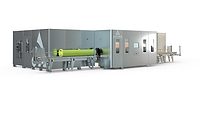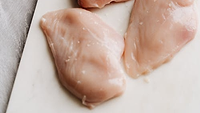No matter how you slice it, meat is a great choice for HPP












Meat products have been one of the main drivers of high pressure processing (HPP) technology in the last few years, spurred on by the need for improved food safety and demand for fresh, clean, ready-to-eat (RTE) foods.
HPP is an effective technique to extend shelf-life maintaining freshness, keeping the flavor and nutritional qualities intact and improving food safety without the need of additivities or artificial preservatives. Deli meats, uncured ham and sausage, pulled chicken and pork, and ground turkey, chicken and beef are among the many meat products that benefit from HPP.
It is estimated that meat represents 30.7 percent of all foods using HPP. The main advantages of HPP include:
- Enhances food safety
- Extends product shelf-life
- Protects brand equity and company reputation
- Enables the sale of cleaner label products
Shelf-life extension and food safety are two of the main reasons producers choose HPP. In fact, according to the 2017 Universal Pure High Pressure Processing Survey, 73.4 percent of producers say they use HPP for shelf-life extension, followed closely by 62.6 percent who say they use it for food safety.
Benefits of HPP for meat
High Pressure Processing (HPP) is fast becoming the food preservation method of choice for producers looking to enhance their food safety program and offer cleaner label products. HPP is effective at addressing vegetative bacteria such as: salmonella, E. coli 0157:H7, Listeria monocytogenes, campylobacter, etc. Additional value is created when processors realize HPP significantly extends product shelf life – often 2X to 4X times longer than non-HPP products.
HPP, being a non-thermal process, maintains the freshest possible organoleptic qualities of products without the use of chemical preservatives. Manufacturers can choose to include HPP on the label or simply highlight the benefits HPP delivers to their customers. The bottom line is HPP is a solid tool the food industry can deploy to protect their brand.
In the meat and poultry industry, the greatest adoption has occurred with RTE meats and, more recently, with fresh products. Sliced RTE meats is a slam-dunk application while there is growing use of HPP for whole muscle products. On the fresh side, HPP has made significant inroads in enhancing the safety of many ground poultry products. Researchers continue to investigate other applications for HPP in the meat industry.
Validation/Testing is key
If you want to use HPP for more than shelf life extension, validation of the process for your particular product may be required.
HPP’s effectiveness will vary based on the product matrix, water activity (Aw), pH, Brix, etc. Today there are some public challenge studies available. If you can’t locate a study that nearly matches your product, a new challenge study is a good idea especially if you want to include HPP as a critical control point (CCP) in your HACCP program.
There are good resources available including the equipment manufacturers, microbiological testing labs, and universities such as University of Nebraska-Lincoln, Illinois Institute of Technology-Chicago, Ohio State University, Virginia Tech, and University of Guelph (Ontario, Canada) to name a few. Their experienced staff will guide you through setting up the correct test protocol and properly reporting the test data.
Consider packaging requirements
Many producers ask whether they need to use special packaging for HPP processing.
The answer: most often not.
The package must be hermetically sealed (airtight) and have one or more surfaces that “flex” to accommodate the temporary volume change during HPP. Water is compressible at HPP pressures—don’t blame your physics teachers, they just didn’t know about HPP! A good rule of thumb is to use a film thickness of 3 mil or thicker.
The pressure is isostatic (i.e. equal on all surfaces) so many existing package materials will work well with the process. To take advantage of the longer shelf life available with HPP, films with barrier properties are often used. You will want to consider using a non-paper-based label, apply the label post HPP, or use preprinted film for your package. Lastly, to increase the efficiency of the HPP process, think about removing most of the air in the package or use a slight vacuum on the package.
Finding the right HPP service provider
There is a network of HPP service providers who can HPP your products for a nominal fee. You’ll also want to consider what other value-add services the 3rd party service provider offers to support your business (e.g. application of labels, assembling, sleeving, kitting, cold storage, logistics, and convenient access to your customer base, etc.). Purchasing HPP technology is a capital-intensive endeavor and requires a commitment to hiring and education/training of staff.
Look for a company that has experience with HPP’ng the products you produce, understands the regulatory requirements and has good QA processes in place. A few HPP 3rd party service providers (like Universal Pure) have multiple locations and equipment redundancy at each location.
As more producers adopt HPP for food safety and to meet consumer demand for fresh, preservative-free foods, new products will be added to the HPP process. No matter how you slice it, HPP is one of the most viable food safety strategies for meat.
A few questions to consider when considering HPP for your meat product:
- If considering HPP to enhance your food safety program, what is the pathogen(s) of concern for your product? What pathogen log reduction is an acceptable benchmark?
- Can you expand your market presence by offering a cleaner label product? Is this a new product or do you want to “clean up” an existing product label?
- Will extending the product shelf life improve the efficiency of your current manufacturing operation? Will adding shelf life present the opportunity to reach a larger market for your product and/or reduce shipping costs?
- Do you believe your existing packaging will work with HPP or is testing needed? Do you have the proper packaging film barrier properties to take advantage of a longer shelf life?
All these questions can be quickly addressed with the help of experienced HPP practitioners. Many of these questions will be addressed at Universal Pure’s upcoming HPP Summit, the leading conference about HPP. For more information, visit https://universalpure.com/hpp-summit/.
Looking for a reprint of this article?
From high-res PDFs to custom plaques, order your copy today!











